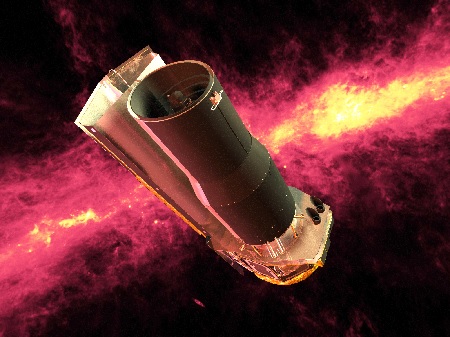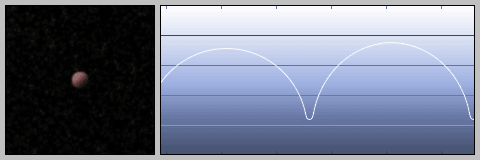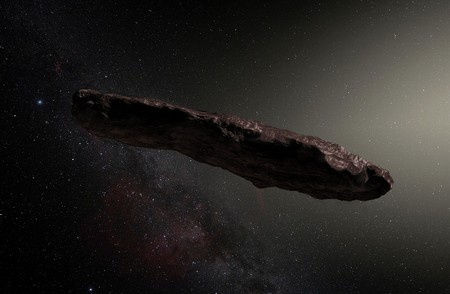When not seeing is believing
A year ago, astronomers identified the first interstellar visitor to our solar system. ‘Oumuamua was studied by nearly every telescope available, including the ultra-sensitive Spitzer infrared space telescope. Despite a whopping 33 hours of observation time, ‘Oumuamua proved too faint for Spitzer to see. Nevertheless, this allowed the observation team to draw significant conclusions. Their analysis of the visitor was published online on 14 November by The Astronomical Journal. ‘If other interstellar objects look like this, there is something wrong with our models of planetary formation’, says University of Groningen astronomer Michael Mueller.
In October 2017, astronomers detected an asteroid-like object with a peculiar orbit. After several checks, it was confirmed that the object originated from outside our solar system and was already on its way out. ‘The initial detection was made by the Pan-STARRS survey telescope, which is dedicated to finding asteroids which have an orbit that brings them close to the Earth’, explains Michael Mueller. He works on the MIRI instrument of the new James Webb Space Telescope at SRON, the Netherlands Institute for Space Research, and at the University of Groningen Kapteyn Institute for Astronomy, but is also involved in studies of ‘Near Earth Asteroids’.

Observation frenzy
The American Congress has given the space organization NASA the task of finding these asteroids, as they can pose a threat to life on Earth – as did the impact of the large asteroid that probably wiped out the dinosaurs. ‘As a result, we now have telescopes dedicated to finding new objects in the sky’, says Mueller. ‘Previously, there were a few objects that appeared to come from outside the solar system, but each time additional observations ruled this out’. That was until October 2017, when the object now known as ‘Oumuamua was the first to be confirmed as a visitor from interstellar space.
This sparked an observation frenzy among astronomers. ‘The first results told us how much light the object reflected. The light curve showed large variations, which meant that the object was probably elongated and tumbling’. The length-to-width ratio was estimated to be 6:1, making it cigar shaped, although a pancake shape is also possible. However, the size could not be determined from the visible light reflection. ‘The resolution was not good enough to measure it’, Mueller adds.
Spitzer
A better way to determine its size would be to measure thermal radiation, the amount of absorbed energy which ‘Oumuamua sends back into space at infrared frequencies. That is where Spitzer and Mueller came in. Mueller works regularly with the team that studies asteroids using this infrared space telescope. ‘We have observation protocols for this kind of work and, based on models of asteroids and the data on visible light reflection, we calculated that 33 hours of observation time should give us valuable information’.

The team applied for ‘Director’s Discretionary Time’ at Spitzer and after a rapid but thorough review, were given their 33 hours. ‘That is a lot’, remarks Mueller. ‘Most astronomers would be very happy with just one hour on this telescope’.
In November 2017, a month after the discovery of ‘Oumuamua, Spitzer was pointed towards the location of the object for a total of 33 hours. However, when the data were analysed, there was no sign of the object. ‘But we know that even this was significant’, explains Mueller. They could now set an upper limit for the amount of thermal radiation emitted by the object. The first conclusion was that it could not be very big, about 140 metres long at most. ‘For a larger object, the thermal radiation would have been visible’.
Planet formation
A second conclusion was that the object could not emit much carbon monoxide or carbon dioxide, as these gases are very visible in the infrared frequencies that Spitzer observes. Such emissions would be expected from a comet-like object, and would also explain why ‘Oumuamua was accelerating when it left the solar system: the emission of gas, induced by heat from the sun, would act as a propellant. Mueller adds that ‘Optical observations showed that it was not emitting much dust either, and dust comes off as water evaporates. So, it just did not look like a comet. It could be a standard rocky object, perhaps with a rough surface that would make it cooler’. Fine surface sand – like that found on the Moon – acts as an insulator and would have produced a warmer object.

This conclusion is unexpected. ‘Interstellar objects are ejected from their own star system. This is easier for comet-like objects that form in the outer regions, where there are lots of volatiles’, says Mueller. So, an interstellar visitor is likely to contain volatiles. However, ‘Oumuamua appeared to be a rocky object associated with the inner regions of a star system. Of course, it is the first interstellar object to be observed, so it might not be representative. ‘But if other interstellar objects look like this, there is something wrong with our models of planet formation’, Mueller concludes.
He has high hopes of observing more interstellar objects like ‘Oumuamua in the near future. ‘With increased monitoring for Near Earth Asteroids, we are bound to find more of these visitors from outside our own solar system’.
Reference: David E. Trilling et al: Spitzer Observations of Interstellar Object 1I/‘Oumuamua. Astronomical Journal, December 2018
See also NASA Learns More About Interstellar Visitor 'Oumuamua
| Last modified: | 01 June 2021 4.15 p.m. |
More news
-
13 May 2024
Trapping molecules
In his laboratory, physicist Steven Hoekstra is building an experimental set-up made of two parts: one that produces barium fluoride molecules, and a second part that traps the molecules and brings them to an almost complete standstill so they can...
-
29 April 2024
Tactile sensors
Every two weeks, UG Makers puts the spotlight on a researcher who has created something tangible, ranging from homemade measuring equipment for academic research to small or larger products that can change our daily lives. That is how UG...
-
16 April 2024
UG signs Barcelona Declaration on Open Research Information
In a significant stride toward advancing responsible research assessment and open science, the University of Groningen has officially signed the Barcelona Declaration on Open Research Information.

